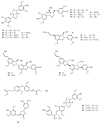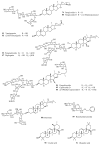Functional, Chemical, and Phytotoxic Characteristics of Cestrum parqui L'Herit: An Overview
- PMID: 39124163
- PMCID: PMC11314090
- DOI: 10.3390/plants13152044
Functional, Chemical, and Phytotoxic Characteristics of Cestrum parqui L'Herit: An Overview
Abstract
Cestrum parqui L'Herit. (Solanaceae family) is a species of forest shrub, self-incompatible and specialized in pollination, widespread in the subtropical area of the planet, and now widely distributed also in the Mediterranean area. The constituents of its leaves have antimicrobial, anticancer, insecticidal, antifeedant, molluscicidal, and herbicidal properties. The spread of this species represents a valuable source of compounds with high biological value. Various research groups are engaged in defining the chemical composition of the different parts of the plant and in defining its properties in view of important and promising commercial applications. To date, there are only a few incomplete reports on the potential applications of C. parqui extracts as selective natural pesticides and on their potential phytotoxic role. Scientific knowledge and the use of extraction techniques for these components are essential for commercial applications. This article summarizes the research and recent studies available on the botany, phytochemistry, functional properties, and commercial applications of C. parqui.
Keywords: Cestrum parqui L’Herit.; flavones; herbicidal activity; insecticidal and antifeedant activity; lignans; oxylipins; secondary metabolites.
Conflict of interest statement
The authors declare no conflicts of interest.
Figures











References
-
- Dewick P.M. Medicinal Natural Products: A Biosynthetic Approach. John Wiley & Sons; Hoboken, NJ, USA: 2002.
-
- Souto A.L., Sylvestre M., Tölke E.D., Tavares J.F., Barbosa-Filho J.M., Cebrián-Torrejón G. Plant-Derived Pesticides as an Alternative to Pest Management and Sustainable Agricultural Production: Prospects, Applications and Challenges. Molecules. 2021;26:4835. doi: 10.3390/molecules26164835. - DOI - PMC - PubMed
-
- [(accessed on 5 May 2024)]. Available online: https://keyserver.lucidcentral.org/weeds/data/media/Html/cestrum_parqui.htm.
-
- L’Héritier de Brutelle C.L., Redouté P.J., Fréret L. Stirpes Novae aut Minus Cognitae, Quas Descriptionibus et Iconibus. Nabu Press; Miami, NY, USA: 1784. Ex Typographia Philippi-Dionysii Pierres.
Publication types
LinkOut - more resources
Full Text Sources

